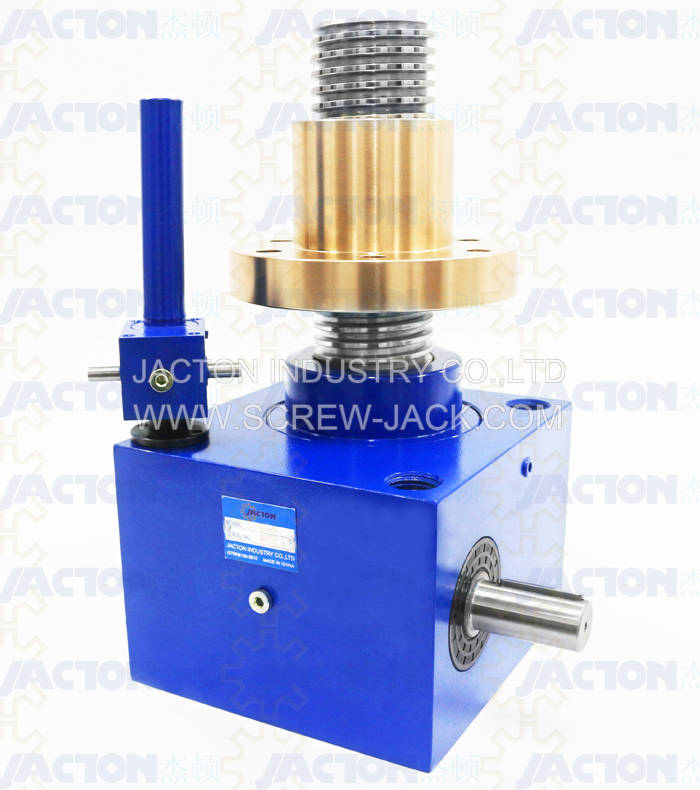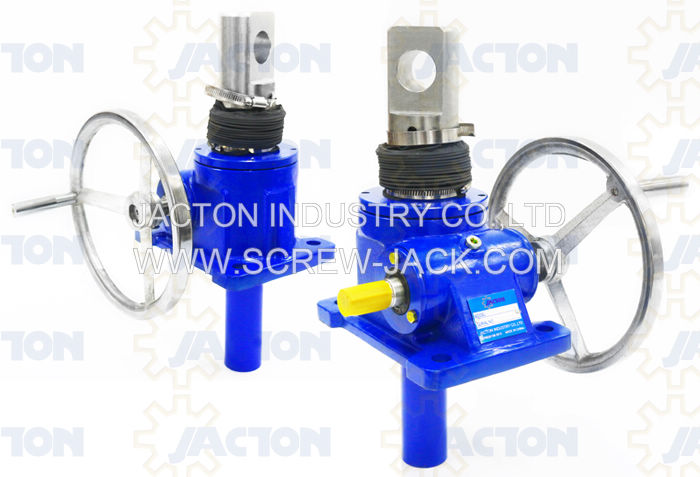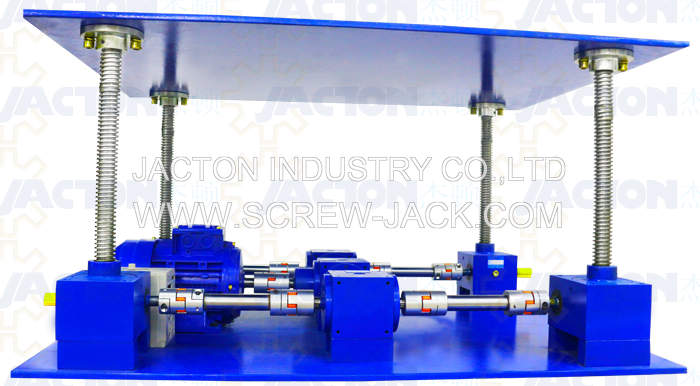News Details
What Is Screw Jack - What Is Worm Gear Screw Jack - How Does A Screw Jack Work - Screw Jack Working Principle - How Screw Jack Works - What Is Mechanical Screw Jack
What is screw jack? what is worm gear screw jack? how does a screw jack work? screw jack working principle? how screw jack works? what is mechanical screw jack? A Screw Jack (also known as a Worm Gear Screw Jack, a Machine Screw Jack or a Ball Screw Jack) is a devise used to convert rotational motion into linear motion. They can be used to push, pull, tension, lock, unlock, tilt, pivot, roll, slide and lift or lower loads, anything from a few kilos to thousands of tonnes. Additionally, screw jacks are increasingly finding uses as alternatives to conventionally pneumatic and hydraulic systems.

The trend to electromechanical actuation from hydraulic actuation. Screw jacks usually operate in high-load applications. The competing technology at high loads tends to be hydraulics; however, hydraulics are less energy-efficient than electro-mechanical actuation provided by screw jacks. Hydraulic systems waste energy as the fluid circulates at constant pressure, regardless of the amount of work required to be carried out by hydraulic positioning. A hydraulic jack or ram requires a constant pressure to maintain its position when holding a load in place. By contrast, an electric motor used to power a screw jack uses energy only when it drives the load to a required position. What's the mechanical advantage of screw jack compared with hydraulic systems? Reduced cost since no need ancillary hydraulic equipment, no hydraulic oil to maintain, no leaks to repair. Environmentally Friendly since no high-pressure oil leaks. Increased Safety. In the event of power loss, screw jacks can be self-locking. More quicker and simple to install, program and tune. Better energy efficiency. Greater levels of precision.

Screw jack is used in applications where linear motion is required. Lifting of any load, pushing or pulling of mechanical equipment, adjusting of tight clearances of mechanical parts can be done by screw jacks, for example: Large dish antenna movement (Top, Center, Bottom), Workplace table adjustments, Drive wheel adjustment to change conveyor flow stops, Conveyor lifts, diverters, Knife blade filter drum skimmer, Furnace combustion gun adjustment, Mechanical clutch linkage, Vacuum furnace lid lifters, Roll lifts, Mandrel pushers Sluice gates. Mechanical capacity of screw jacks is between 1/4-tonnes and 100-tonnes. Jack screws can be used as linear motors, linear actuators, or mechanical lifts depending on type of motion. Screw jacks are essential components in automated machinery. Safety and legislative concerns drive the automation of handling and lifting of heavy loads, particularly in regions which have developed workplace and health and safety legislation.

There are a few Screw Jack Design available including Translating, Keyed and Traveling Nut. All of them can be achieved with either a machine screw jack or ball screw jack. Do you want to find the correct jacks design for your application?
1. Translating screw Jacks are most often selected. The main components of screw jacks are gear housing, trapezoidal lifting screw, worm screw and worm gear. Worm screw is rotated manually or by motor, then the worm gear will be rotated by the worm screw and the lifting screw moves through the rotating worm gear. The linear motion speed of lifting screw depends on thread size and rotation ratio of worm gears.
2. Traveling Nut screw Jacks are another option. The lifting screw does not move up and down. It only rotates around its axis. The travelling nut moves along the screw. The lifting nut of screw jack is made of bronze to decrease friction. This type of jack is ideal for space limit applications that cannot accommodate a screw protection tube or that require a flush mount.
3. Keyed screw Jacks(also known as anti-rotation screw jack) are used any time rotation of the lifting screw is not restrained. For instance, when you must lift the jack to meet a load. This is how they work: A key, fixed to the jack housing and inserted into a keyway milled into the length of the lifting screw forces the lifting screw to translate without rotating. It is available in translating models.


The trend to electromechanical actuation from hydraulic actuation. Screw jacks usually operate in high-load applications. The competing technology at high loads tends to be hydraulics; however, hydraulics are less energy-efficient than electro-mechanical actuation provided by screw jacks. Hydraulic systems waste energy as the fluid circulates at constant pressure, regardless of the amount of work required to be carried out by hydraulic positioning. A hydraulic jack or ram requires a constant pressure to maintain its position when holding a load in place. By contrast, an electric motor used to power a screw jack uses energy only when it drives the load to a required position. What's the mechanical advantage of screw jack compared with hydraulic systems? Reduced cost since no need ancillary hydraulic equipment, no hydraulic oil to maintain, no leaks to repair. Environmentally Friendly since no high-pressure oil leaks. Increased Safety. In the event of power loss, screw jacks can be self-locking. More quicker and simple to install, program and tune. Better energy efficiency. Greater levels of precision.

Screw jack is used in applications where linear motion is required. Lifting of any load, pushing or pulling of mechanical equipment, adjusting of tight clearances of mechanical parts can be done by screw jacks, for example: Large dish antenna movement (Top, Center, Bottom), Workplace table adjustments, Drive wheel adjustment to change conveyor flow stops, Conveyor lifts, diverters, Knife blade filter drum skimmer, Furnace combustion gun adjustment, Mechanical clutch linkage, Vacuum furnace lid lifters, Roll lifts, Mandrel pushers Sluice gates. Mechanical capacity of screw jacks is between 1/4-tonnes and 100-tonnes. Jack screws can be used as linear motors, linear actuators, or mechanical lifts depending on type of motion. Screw jacks are essential components in automated machinery. Safety and legislative concerns drive the automation of handling and lifting of heavy loads, particularly in regions which have developed workplace and health and safety legislation.

There are a few Screw Jack Design available including Translating, Keyed and Traveling Nut. All of them can be achieved with either a machine screw jack or ball screw jack. Do you want to find the correct jacks design for your application?
1. Translating screw Jacks are most often selected. The main components of screw jacks are gear housing, trapezoidal lifting screw, worm screw and worm gear. Worm screw is rotated manually or by motor, then the worm gear will be rotated by the worm screw and the lifting screw moves through the rotating worm gear. The linear motion speed of lifting screw depends on thread size and rotation ratio of worm gears.
2. Traveling Nut screw Jacks are another option. The lifting screw does not move up and down. It only rotates around its axis. The travelling nut moves along the screw. The lifting nut of screw jack is made of bronze to decrease friction. This type of jack is ideal for space limit applications that cannot accommodate a screw protection tube or that require a flush mount.
3. Keyed screw Jacks(also known as anti-rotation screw jack) are used any time rotation of the lifting screw is not restrained. For instance, when you must lift the jack to meet a load. This is how they work: A key, fixed to the jack housing and inserted into a keyway milled into the length of the lifting screw forces the lifting screw to translate without rotating. It is available in translating models.

Product List
Manual Electric Screw Jack
Worm Screw Jack
- JTC Cubic Screw Jack
- JTM Worm Screw Jack
- JSS Stainless Steel Jack
- JT Acme Screw Jack
- JTW Machine Screw Jack
- Through Holes Screw Jack
- Custom Made Screw Jack
Ball Screw Jack
Bevel Gear Jack
Miter Gearbox
- JT Classic Miter Gearbox
-
- Order Code for Classic Miter Gearbox
- Classic Miter Gearbox description
- JT15 Miter Gearbox
- JT19 Miter Gearbox
- JT25 Miter Gearbox
- JT32 Miter Gearbox
- JT40 Miter Gearbox
- JT45 Miter Gearbox
- JT50 Miter Gearbox
- JT60 Miter Gearbox
- JT72 Miter Gearbox
- JT85 Miter Gearbox
- Flange Input Solid Output Shaft Gearbox
- JTP Cubic Miter Gearbox
-
- Order Code for Cubic Miter Gearbox
- Cubic Miter Gearbox description
- JTP65 Small Miter Gearbox
- JTP90 Miter Gearbox
- JTP110 Miter Gearbox
- JTP140 Miter Gearbox
- JTP170 Miter Gearbox
- JTP210 Miter Gearbox
- JTP240 Miter Gearbox
- JTP280 Miter Gearbox
- Solid Input and Output Shafts Gearbox
- Solid Input and Hollow Output Gearbox
- Flange Input and Solid Output Gearbox
- Flange Input and Hollow Output Gearbox
- JTA Alu. Miter Gearbox
Lift System and Accessories
- Screw Jack System
- Lift System Accessories
-
- Flexible Jaw Coupling
- Overload Safety Couplings
- Aluminum Couplings
- Telescopic Universal Joint
- Rigid Shaft Couplings
- Universal Joint
- Cast Iron Hand Wheel
- Connecting Shafts
- Aluminum Handwheel
- YVF2 Series Variable Speed AC Motor
- Brake motors
- Three Phase Electric Motor
- Screw Jack Motor Flange
- Single Phase Induction Motors
- K Helical Bevel Geared Motor
- R Helical Geared Motor
- Worm Gear Reducer
- 12V 24V DC Geared Motor
- Proximity Switches
- Limit Switches
- Pillow Blocks
- Pillow Block Flange Bearing
- Digital Position Indicator
- Flange Blocks
- Ball Joint Rod End Bearing
- Bellows Boot
- Helical Gear Motor
- 12V 24V DC Motor
- Linear Bushings and Shafts
- Trunnion Adapters
- Servomotor
- Rotary Encoder
- Low Backlash Planetary Gearheads
- Stepper Motor
- 24V Planetary Gear Reducer
- Planetary Speed Reducer
- Frequency Inverter
- Hydraulic Cylinder Rod End Bearing
- Lift System Applications
Linear Actuators
- LAP Electric Linear Actuator
-
- 100KG Parallel Electromechanical Linear Actuators
- 250KG Parallel Electro Mechanical Linear Actuators
- 500KG Parallel Mount Rod Style Linear Actuators
- 630KG Parallel Mount Electric Cylinder Linear Actuators
- 1000KG Parallel Mount Industrial Linear Actuators Acme Screw
- 1600KG Parallel Electro-mechanical Actuators Heavy Duty
- 2500KG Parallel Mount Electric Cylinders Actuator
- 4000KG Heavy Duty Electric Linear Actuators Parallel Mount
- 6300KG Parallel Motor Drive Electric Actuator Linear Actuator
- 8000KG Parallel Electric Motor-Drive Linear Actuator
- 10000KG Parallel Mount Motorized Electric Linear Actuator
- 15000KG Parallel Industrial Motor Linear Actuator
- 20000KG Parallel Indistrial Motor Drive Linear Actuator
- 25000KG Parallel Electric Motor Linear Electric Actuator
- LA Electric Linear Actuators
-
- 10KG In-line Mini Electric Linear Actuators with Brake Motor
- 25KG In-line Electric Linear Actuator Push Rod
- 63KG In-line 700mm Stroke Electric Motor Linear Actuator
- 90KG In-line High Speed Motor Drive Electric Linear Actuator
- 100KG In-line Fast Speed Electric Linear Motor Linear Actuator
- 300KG Inline Industrial Electromechanical Linear Actuator
- 500KG In-Line Electric Linear Actuator
- 700KG Inline Heavy Electro Mechanical Actuators
- 1000KG In-line Heavy Duty AC Volt Industrial Linear Actuators
- JTE Classic Electric Cylinder
- Mechanical Linear Actuators
- JCA Cubic Electric Cylinder
Application
Jacton Industry Co.,Ltd.
 Contact: Warren Lee
Contact: Warren Lee
 Skype: jactonjack
Skype: jactonjack
 T: 86-769-81585810
T: 86-769-81585810
 F: 86-769-81585852
F: 86-769-81585852
 E: sales@jactonindustry.com
E: sales@jactonindustry.com
 W: www.screw-jack.com
W: www.screw-jack.com

 Contact: Warren Lee
Contact: Warren Lee Skype: jactonjack
Skype: jactonjack T: 86-769-81585810
T: 86-769-81585810  F: 86-769-81585852
F: 86-769-81585852  E: sales@jactonindustry.com
E: sales@jactonindustry.com  W: www.screw-jack.com
W: www.screw-jack.com 
VAT No. 9144190007026567X3, Copyright ©2013 www.screw-jack.com Jacton Industry Co.,Ltd. All Rights Reserved Site Map
Building 2, No. 1, DongCheng Road, Chang An, Dongguan, Guangdong, China. Phone: 86-769-81585810 | Fax: 86-769-81585852
China Screw Jack,Ball Screw Jack,Machine Screw Jack,Worm Gear Screw Jack,Bevel Gear Screw Jack,Miter Gearbox,Screw Jack Lift System Manufacturer
China Screw Jack,Ball Screw Jack,Machine Screw Jack,Worm Gear Screw Jack,Bevel Gear Screw Jack,Miter Gearbox,Screw Jack Lift System Manufacturer













